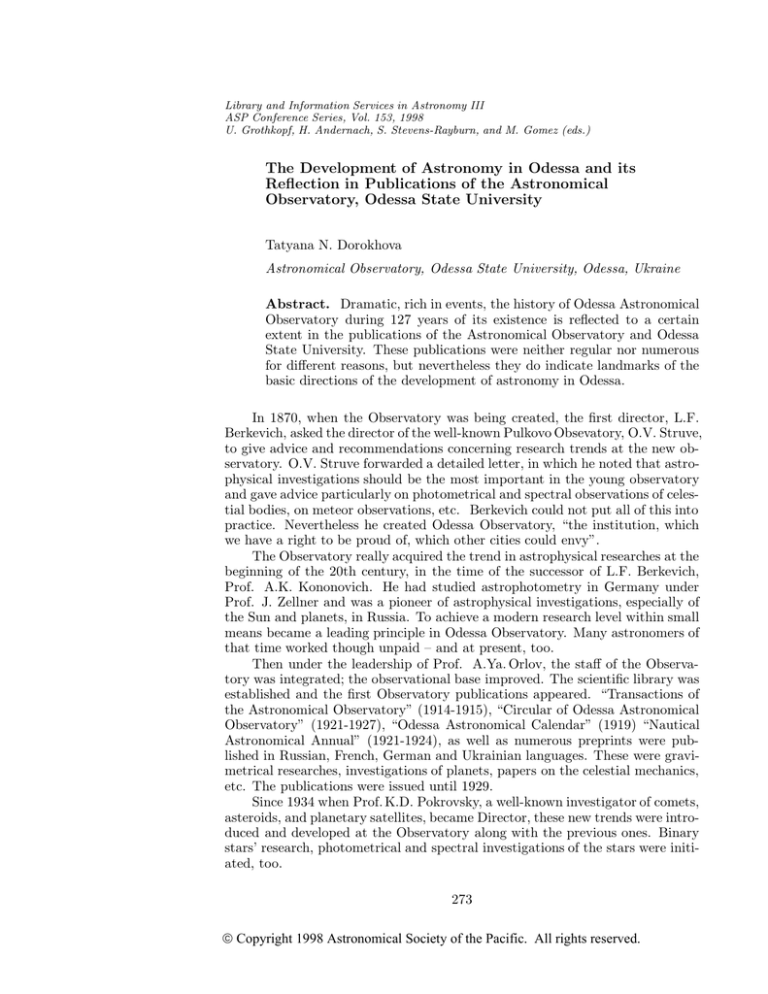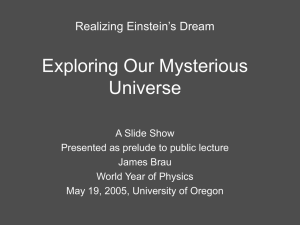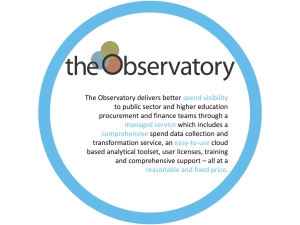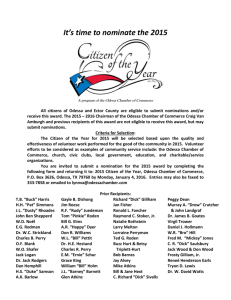
Library and Information Services in Astronomy III
ASP Conference Series, Vol. 153, 1998
U. Grothkopf, H. Andernach, S. Stevens-Rayburn, and M. Gomez (eds.)
The Development of Astronomy in Odessa and its
Reflection in Publications of the Astronomical
Observatory, Odessa State University
Tatyana N. Dorokhova
Astronomical Observatory, Odessa State University, Odessa, Ukraine
Abstract. Dramatic, rich in events, the history of Odessa Astronomical
Observatory during 127 years of its existence is reflected to a certain
extent in the publications of the Astronomical Observatory and Odessa
State University. These publications were neither regular nor numerous
for different reasons, but nevertheless they do indicate landmarks of the
basic directions of the development of astronomy in Odessa.
In 1870, when the Observatory was being created, the first director, L.F.
Berkevich, asked the director of the well-known Pulkovo Obsevatory, O.V. Struve,
to give advice and recommendations concerning research trends at the new observatory. O.V. Struve forwarded a detailed letter, in which he noted that astrophysical investigations should be the most important in the young observatory
and gave advice particularly on photometrical and spectral observations of celestial bodies, on meteor observations, etc. Berkevich could not put all of this into
practice. Nevertheless he created Odessa Observatory, “the institution, which
we have a right to be proud of, which other cities could envy”.
The Observatory really acquired the trend in astrophysical researches at the
beginning of the 20th century, in the time of the successor of L.F. Berkevich,
Prof. A.K. Kononovich. He had studied astrophotometry in Germany under
Prof. J. Zellner and was a pioneer of astrophysical investigations, especially of
the Sun and planets, in Russia. To achieve a modern research level within small
means became a leading principle in Odessa Observatory. Many astronomers of
that time worked though unpaid – and at present, too.
Then under the leadership of Prof. A.Ya. Orlov, the staff of the Observatory was integrated; the observational base improved. The scientific library was
established and the first Observatory publications appeared. “Transactions of
the Astronomical Observatory” (1914-1915), “Circular of Odessa Astronomical
Observatory” (1921-1927), “Odessa Astronomical Calendar” (1919) “Nautical
Astronomical Annual” (1921-1924), as well as numerous preprints were published in Russian, French, German and Ukrainian languages. These were gravimetrical researches, investigations of planets, papers on the celestial mechanics,
etc. The publications were issued until 1929.
Since 1934 when Prof. K.D. Pokrovsky, a well-known investigator of comets,
asteroids, and planetary satellites, became Director, these new trends were introduced and developed at the Observatory along with the previous ones. Binary
stars’ research, photometrical and spectral investigations of the stars were initiated, too.
273
Copyright 1998 Astronomical Society of the Pacific. All rights reserved.
274
T. N. Dorokhova
The publication activities of the Observatory were resumed. Three volumes of “Odessa State University transactions. Collections of the Astronomical
Observatory” were published in 1935, 1937 and 1940. The publications were
opened by a discourse of Prof. K.D. Pokrovsky about the Observatory. In the
second and third volumes the expedition to Siberia for observations of total Solar eclipse, 19 June 1936, and the scientific results of these observations were
described in detail (Pokrovsky & Rojtbak 1940). Varied papers on research
problems, studied at the Observatory at that time were published as well. The
publications were in Ukrainian or French (these had another title: “Travaux de
l’Université d’Odessa. Reciel de l’observatoire astronomique O.U.”) with summaries in Russian and French. It should be noted that many astronomers of
those days had a complete command of French. In the last volume the articles
were written in Russian and the first summary in English appeared (Shulberg
1940).
The Great Patriotic War, 1941-1945, broke off the astronomical research
and its publications in Odessa, but the Observatory was saved. In 1945 Prof.
V.P. Tsessevich, a well-known investigator of variable stars, was appointed Director of the Observatory. “Publications” were out once more in 1947. That
edition did not continue the previous one and was commenced from volume 1,
issue 1. From 1947 to 1963 five volumes (ten issues) were published in Russian.
Those collections reflected the activity of the Observatory only to a certain extent. Many astronomers published their papers in central journals, such as the
well-known Soviet titles “Variable Stars”, “Astronomical Journal”, “Astronomical Circular”, etc. The global subjects of investigations and, on the contrary,
small and applied works were edited in the “Publications”. Articles on astrometry and instrumentation, celestial mechanics and binary stars, investigations
of Solar prominences and spots were presented, but more and more articles on
variable stars appeared in those issues. A huge amount of observational material
accumulated by Prof. V.P. Tsessevich needed to be put into order and summarized. Many of the scientific researchers were involved in this work. Vol. 4
contained a monograph by Prof. V.P. Tsessevich “Investigations of the eclipsing
variable stars”, observations and descriptions of 252 stars.
Two branches of research highly developed at that time should be noted,
as well.
In 1945 the Observatory began the co-operative work on photographic observations of small planets. This new field of investigations yielded significant
results concerning mass and density of asteroids’ ring (see, for example, Putilin
1952)
In 1957-1958 during the International Geophysical Year, Odessa Astronomical Observatory became a leader of meteors’ investigations in the USSR. New
original equipment constructed by the scientists of the Observatory, new research
methods, the experience in the observational arrangement accumulated during
the previous decade made it possible. And Vol. 5 N2 of the “Publications” was
dedicated to these results.
Vol. 6 appeared almost 30 years later, in 1993. Great changes took place in
our country and in the Observatory. The staff of the Observatory consisted of 12
members in 1936, of 30 in 1957 and amounted to nearly 130 members in 1992.
Toward the 1980s certain developed research fields in the Observatory had been
The Development of Astronomy in Odessa
275
formed as corresponding departments: astrometry, comet and meteor research,
physical variable stars, spectrophotometric and photometric research on stars,
eclipsing and cataclysmic binaries, artificial Earth’s satellites and applied, but
very important departments of telescope construction and the designing and
manufacturing of astronomical equipment.
Prof. V.P. Tsessevich, who headed the Observatory for 44 years, died in
1983. Prof. Valentin G. Karetnikov was elected Director.
In 1991 the USSR was destroyed. Ukraine became an independent state.
Following events as an avalanche swamped the country. In the frame of this article it is possible to note only two of the most essential moments of the process.
On one side, the integration of the former Soviet science with world science. On
the other side, steady and significant cuts of the financial support of many institutions, Odessa Observatory among them. Both these tendencies stimulated
the scientific and “author’s” activity of the research. The number of published
papers was sharply increased. The necessity to have our own publication was
urgent for the Observatory. The Editorial Board with Editor-in-Chief Prof. V.G.
Karetnikov decided to bring out the “Publications” in English, so that the journal could be read in any country of the world.
Vol. 6 was a sign of continuity and tribute to traditions of the former Soviet
science to a certain extent. Papers on astrometry, comet and meteor research
were presented as a tradition. Most profound and serious works were done in the
director’s research field, the eclipsing binary systems. Although plenty of scientific researchers have been engaged in variable stars’ observations, there were
no articles on variable star observations using our own instrumentation. But a
number of papers are based on the observations obtained at the 6 m telescope of
SAO (Special Astrophysical Observatory, Russian Academy of Sciences). Such
high quality observational material, reduced by modern methods, pushed the development of a new trend of research, chemical composition in the atmospheres
of stars. These papers, written with the participation of the scientists of leading
observatories of the Soviet Union and discussed at the large-scale scientific conferences, had an advanced and modern level. It should be noted that traditions
of inter-observatories’ cooperation prove to be very fruitful for the improvement
of the research level in Odessa Observatory.
Separately, vol. 8 included “The spectrophotometric star catalogue” (Komarov et al. 1995). The catalogue comprises data on the energy distribution in
spectra of 555 stars of different spectral types and luminosity classes. Results
are used from stellar spectrophotometry obtained in astronomical observatories
of Moscow, Alma-Ata, the Crimea, St.-Petersburg, Odessa throughout the last
25 years.
The rest of the volumes of “Publications” contained the proceedings of
various conferences, which were organized almost each “mellow season” (that is
early September) in Odessa, in spite of financial and other technical difficulties.
The meetings in Odessa, a well-known seaport and “a capital of humor”, usually
were well-arranged, varied and lively. Vol. 7 was dedicated to the conference
“Modern problems of astrophysics” which was held in 1993, vol. 9 - to the
conference “125th Anniversary of Odessa Astronomical Observatory” (1996),
and vol. 10 - (in prep.) to the conferences devoted to the 90th Anniversary of
Prof. V.P. Tsessevich (1997).
276
T. N. Dorokhova
In the Foreword to vol. 7 Prof. V. G. Karetnikov (1994) noted: “153 scientists from 6 countries of the Commonwealth of Independent States as well as
astronomers from Canada, Estonia, Finland, France, Germany, Hungary, Italy,
the Netherlands, Poland, Slovakia, UK, USA contributed to the conference.
...15 review research reports and 109 section informations were carried out.” At
present the leading direction is the investigation of close binary systems. For
the study of physical variable stars the widest range of variability was considered: from rapid photometry of flare activity of Wolf-Rayet stars, 1 sec., to
periodogram analysis of red variables showing the periodicities to 10000 days.
The investigations of chemical composition and evolution of stars of all spectral
types and luminosity classes advance extremely quickly.
New branches of the science are displayed in “Publications”: mathematical
methods of analysis of astronomical data, cosmology and extragalactic objects,
history of astronomy.
The exceedingly high activity of scientific researchers of the Observatory is
remarkable. Some researchers have published 2, 3 or 4 papers each, covering
different areas of science. A great contribution was made by the invited leading
astronomers A.M. Cherepashchuk, R.E. Gershberg, I. Pustilnik and others.
“Publications” have gotten their “own face” thanks to a high professionalism and extremely high capacity for work of I.L. Andronov and L.L. Chinarova,
the responsible for the latest issues. A large and selfless work was done by
I.V. Gabestro, who translated or corrected a significant part of the articles in
English.
In this way “Odessa Astronomical Publications” became actually an international collection with the latest, varied and fascinating papers. And hospitable
Odessa is again waiting for guests who will bring the best presents, products of
their intellectual creative work.
References
Karetnikov V.G. 1994, Odessa Astronomical Publications, 7, 3
Komarov N.S., Dragunova A.V., Belik S.I., Karamysh V.F., et al. 1995, Odessa
Astronomical Publications, 8, 3
Pokrovsky K.D., Rojtbak Yu.B. 1940, Travaux de l’Université d’Odessa. Reciel
de l’observatoire astronomique O.U., 3, 5
Putilin I.I. 1952, Odessa Astronomical Publications (Rus), 2, N2, 7
Shulberg A.R. 1940, Travaux de l’Université d’Odessa. Reciel de l’observatoire
astronomique O.U., 3, 167







